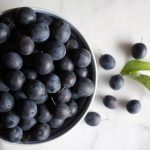Damson Wine
Damson wine is a luscious homemade plum wine, crafted with full flavored damsons. It finishes more like a fine red wine than a country wine, and it's well worth seeking out damsons to make this at home!
Servings: 20 glasses, Makes 1 gallon (about 4 bottles)
Equipment
Ingredients
- 4 lbs damson plums
- 3 lbs Sugar
- 1 lb sultana raisins golden raisins
- Water to fill
- 1 tsp yeast nutrient
- 1 tsp Pectic Enzyme
- 1 packet wine yeast see note
- Optional ~ Campden Tablet and Potassium Sorbate for Stabilizing I do not use these
Instructions
- If using frozen damsons, thaw. For fresh, halve the fruit and destone it.
- Crush damsons and place them in your primary fermentation vessel. (You may use a brew bag, if desired.)
- Add sugar, sultanas and hot water. Stir to incorporate.
- Once cool, add the pectic enzyme and yeast nutrient. Add the wine yeast last, rehydrating in a bit of warm water before adding.
- Stir the mixture.
- Fill with enough water to leave 2 inches of headspace and seal with a water lock.
- Ferment in primary until most of the active fermentation has died out (about 4 or 5 days).
- Siphon to a clean fermentation vessel for secondary, leaving the fruit and sediment behind. Top with more water to fill the carboy and seal with a water lock.
- Ferment in secondary until the wine clears. Additional rackings (up to 2) may be needed to discard sediment and help clear the wine.
- At the end of secondary, sample your wine and adjust as needed (see notes for backsweetening).
- Siphon the wine into wine bottles and seal with wine corks.
- Allow to age at least 4 weeks before drinking or longer if possible.
Notes
Amount of Fruit
4 lbs of damsons are the recommended amount for making damson wine. This will ensure a full-bodied and flavorful wine.Yeast
For damson wine, try to find a wine yeast with a moderate alcohol tolerance. Bordeaux wine yeast is said to be quite nice for damson wine but can be difficult to source. Lalvin EC-1118 or champagne yeast is another nice choice. See notes within the article for the specific qualities of each yeast.Stabilizing and Back Sweetening
If the wine is too dry at the end of secondary, you can always backsweeten. To do so, rack the wine to a fresh carboy and stabilize it. Adding sugar to unstabilized wine can cause the ferment to reactivate, and bottled wine to burst under pressure (this is more likely if you use an especially strong fermenter in terms of wine yeast). Stabilize wine by adding 1 Campden tablet and ½ teaspoon potassium sorbate, and waiting 24 hours before adding sugar to ensure the yeast has died off. Create a simple syrup of equal parts sugar and water to add to your wine. Amounts vary by taste, but starting with ½ cup of sugar for 1 gallon of wine is a good place to start. See further notes within the article regarding stabilizing and back sweetening.Damson Mead
For damson mead, the recommended time spent in secondary is 2 to 6 months as honey is less digestible for yeast than sugar. To substitute honey for sugar, use about one quart (3 lbs) of honey for every 3 quarts of water.Nutrition
Calories: 371kcal | Carbohydrates: 96g | Protein: 1g | Fat: 1g | Saturated Fat: 0.1g | Polyunsaturated Fat: 0.1g | Monounsaturated Fat: 0.1g | Sodium: 7mg | Potassium: 331mg | Fiber: 3g | Sugar: 77g | Vitamin A: 313IU | Vitamin C: 10mg | Calcium: 12mg | Iron: 1mg
